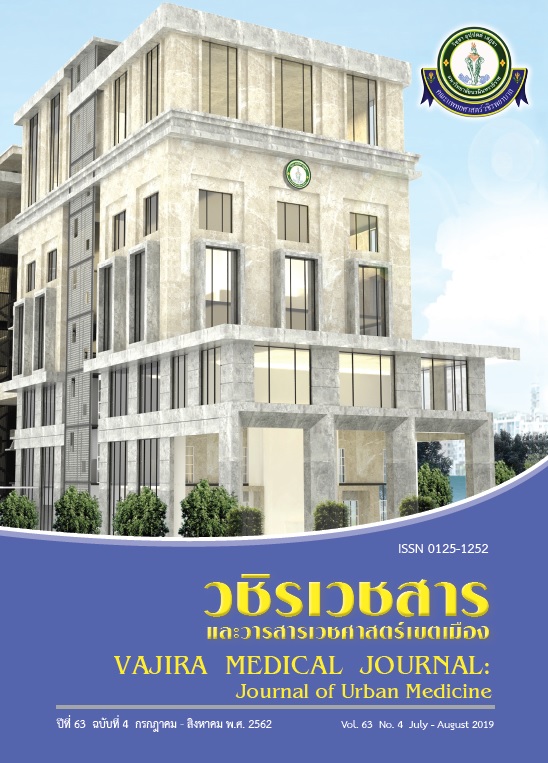Febrile Neutropenia in Pediatric Cancer Patients Receiving Chemotherapy at Faculty of Medicine Vajira Hospital, Navamindradhiraj University
Main Article Content
Abstract
Objective: To study the prevalence, type of bacteria and site of infection that cause febrile neutropenia in pediatric cancer patients receiving chemotherapy.
Methods: A retrospective study from medical record of patients under 15 years of age diagnosed with febrile neutropenia receiving chemotherapy and admitted at the Department of Pediatrics, Faculty of Medicine Vajira Hospital, Navamindradhiraj University from January 1st , 2011 to September 30th , 2016.
Results: There were 40 patients with 96 episodes of febrile neutropenia, male 50% and female 50%. The predominant underlying malignancies were solid tumor 18 patients (45%) followed by acute lymphoblastic leukemia 15 patients (37.5%). Causes of febrile neutropenia were identified 54.2% (pneumonia 14.6%, acute gastroenteritis 12.5%, urinary tract infection 10.4%, mucositis 9.4%, bacteremia 9.4%). The prevalence of bacterial infection was 27.1%. The organisms were gram negative 89.7 %(E. coli 34.6 %, P. aeruginosa 19.2%, K. pneumoniae 15.4%) and gram positive 10.3% (Enterococcus spp. 66.7% and methicillin sensitive S. aureus 33.3%). The most common empirical antibiotics were ceftazidime plus amikacin (68.7%). The antibiotics were changed after treatment 48 hours because of clinical worsening 21%. The next antibiotics used were meropenem 31.2%, vancomycin 16.6% and add amphotericin B 14.6%. Treatment outcomes were recovery (84.4%), with complications (10.4%) and death (5.2%). The risk factors of death in this study was duration of febrile neutropenia more than 7 days (Adjusted OR 22.0; 95%CI: 2.3 – 211.7; p 0.007)
Conclusion: The prevalence of bacterial infection in febrile neutropenia was 27.1%. The organisms were gram negative 89.7 % (E. co li, P. aeruginosa, K. pneumoniae) and gram positive 10.3% (Enterococcus spp. and methicillin sensitive S. aureus). The common sites of infection were pneumonia, gastroenteritis, urinary tract infection, mucositis and bloodstream infection. The risk factors of death was duration of febrile neutropenia more than 7 days.
Downloads
Article Details
References
Ozdemir ZC, Koc A, Aycicek A. Microorganisms isolate from cultures and infection focus and antibiotic treatments in febrile neutropenic children from Sanliurfa, Turkey. Turk J Pediatr. 2016;58:47-53.
El-Mahallawy, Hadir H, Abdel R. Chemotherapy induced febrile neutropenia and its association with nosocomial bacteremia: risk factor and prognosis. Bull High Inst Public Health. 2008;38:818-34.
Aslan S, Citak EC, Yis R, Degirmenci S, Arman D. Bacterial spectrum and antimicrobial susceptibility pattern of bloodstream infections in children with febrile neutropenia: Experience of single center in southeast of Turkey. Indian J Microbiol. 2012;52:203-8.
Lam JC, Chai JY, Wong YL, Tan NW, Ha CT, Chan MY, et al. Causative pathogens of febrile neutropenia in children treated for acute lymphoblastic leukemia. Ann Acad Med Singapore. 2015;44:530-4.
Cortés JA, Cuervo S, Gómez CA, Bermúdez D, Martínez T, Arroyo P. Febrile neutropenia in the tropics: A description of clinical and microbiological findings and their impact on inappropriate therapy currently used at an oncological reference center in Colombia. Biomédica. 2013;33:70-7.
Robles MA, Ojha RP, González M, Ojeda-Diezbarroso K, Dorantes-Acosta E, Jackson BE, et al. Bloodstream infections and inpatient length of stay among pediatric cancer patients with febrile neutropenia in Mexico City. Am J Infect Control. 2014;42:1235-7.
Al-Mulla NA, Taj-aldeen SJ, Shafie SE, Janahi M, Al-Nasser AA, Chandra P. Bacterial bloodstream infections and antimicrobial susceptibility pattern in pediatric hematology/oncology patients after anticancer chemotherapy. Infect Drug Resist. 2014;7:289-99.
Viscoli C, Varnier O, Machett M. Infections in patients with febrile neutropenia: Epidemiology, microbiology, and risk stratification. Clin Infect Dis. 2005;40:S240-5.
Sanboonrat P, Chainansamit S, Sriraksa K. Febrile neutropenia in children with acute leukemia. Khon Kaen Med J. 2009;33:2-8.
Sanpakit K, Phuakpet K, Veerakul G, Narkbunnam N, Chokephaibulkit K. Evaluation of guideline for treatment of febrile neutropenia in pediatric cancer at Siriraj Hospital. J Med Assoc Thai. 2005; 88: S124-34.
Wangirapan A, Natesirinilkul R, Thanarattanakorn P, Charoenkwan P. Bacteremia in oncologic pediatric patients with febrile neutropenia at Chiang Mai University Hospital between 2007 and 2009. Chiang Mai Med J. 2012;51:71-8.
Borisutbuathip D, Kongpanvijit O. Febrile neutropenia in acute leukemic patients receiving chemotherapy at Faculty of Medicine Vajira Hospital, Navamindradhiraj University. Vajira Med J. 2014;58:21-32.
Downes KJ, Zaoutis TE, Shah SS. Guidelines for management of children with fever and neutropenia. J Pediatric Infect Dis Soc. 2013;2:281–5.
Crawford J, Dale DC, Lyman GH. Chemotherapy-induced neutropenia: Risks, consequences, and new directions for its management. Cancer. 2004;100:228-37.
Oberoi S, Suthar R, Bansal D, Marwaha RK. Febrile neutropenia: Outline of management. Indian J Pediatr. 2013;80:138-43.
Expert Committee of Thai Pediatric Nephrology Association. Clinical practice guideline of urinary tract infection in children aged 2 months to 5 years. [cited 2017 Dec 1] Available from: http://www.thaipediatrics.org/Media/media- 20161208143440.pdf.
Danchaivijitr S, Dhiraputra C, Santiprasitkul S, Judang T. Prevalence and impact of nosocomial infections in Thailand 2001. J Med Assoc Thai. 2005;88:S1-9.
Rajesh V, Stephen T, Douglas E. Management
of Oral Mucositis in Patients with Cancer.
Dent Clin North Am. 2008;52:1-17.
Tantracheewathorn T. Infections in immunocompromised host. In: Watanaveeradej V, Chokephaibulkit K, eds. Update on pediatric infectious diseases 2017. Bangkok: Beyond Enterprise, Ltd; 2017. p.212-34.
Freifeld AG, Bow EJ, Sepkowitz KA, et al. Clinical practice guideline for the use of antimicrobial agents in neutropenic patients with cancer: 2010 update by the Infectious Diseases society of America. Clin Infect Dis. 2011;52:e56-e93.
Fisher BT, Sung L. The febrile neutropenic patient. In: Cherry JD, Harrison GJ, Kaplan SK, Steinbach WJ, Hotez PJ, eds. Feigin and Cherry’s textbook of pediatric infectious diseases. 7th ed. Philadelphia: Elsevier Saunders; 2014. p.921-33.


